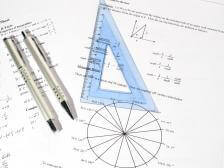The World of Trigonometry
You’ve probably heard of sine, cosine, and tangent before. But do you actually know what they are? While they sound like complicated ideas, they’re really not. Keep on reading to learn more about the origins and uses of trigonometry.

If that’s you, good news: today we’re going to kick off a discussion of trigonometry—a topic that sounds hard but is really pretty easy, and a subject that a bunch of those bewildering buttons can help you deal with. What are those magic buttons? And what do they do? Stay tuned because those are precisely the questions we’ll be answering over the next few weeks.
Sponsor: Netflix Instant Streaming. Watch thousands of TV episodes and movies on your PC, Mac, iPad, iPhone or Touch. Or on your TV through your XBox, PS3 or Wii. All streamed instantly by Netflix, saving you time, money and hassle. For a free 30-day trial, including the new Netflix Original Series House of Cards, go to Netflix qdt.
What Is Trigonometry?
Before we can talk about what those “sin,” “cos,” and “tan” buttons on your calculator are for, we first need to talk about trigonometry. Why? Because those buttons represent three of the most common functions that are used in trigonometry—so called “trigonometric functions”: sine, cosine, and tangent.
So, what is all of this trigonometry stuff about?
Well, as you might be able to guess from the first part of the word, the part of math known as trigonometry deals with triangles. The word trigonometry actually comes from the Greek words trigon meaning—no big surprise here—triangle, and metron meaning something like “measure.” Which makes a lot of sense since trigonometry is all about figuring out clever ways to measure and calculate the properties of the components of triangles—namely their three sides and three angles.
The basic ideas underlying trigonometry have been around for a while…a very long while. In fact, trigonometry is one of the older branches of mathematics. Its ideas were first developed over 2,000 years ago by people who were figuring out the most efficient way to observe, measure, and make sense of the movements of astronomical bodies. So now you know who to blame for those extra buttons on your calculator (although, in truth, you really ought to be thanking them!).
The World of Right Triangles

Okay, that’s great to know, but to understand what it means, we need to understand what a right angle is. Fortunately that’s pretty easy. In fact, the definition is right there in the name—just look at the similarity between the term “right angle” and the word “rectangle” (rect-angle). They practically look and sound the same, right? Well, that’s not by chance. After all, the four corners of a rectangle each form a right angle!
So the world of trigonometry that we’re going to be talking about has to do with these special triangles known as right triangles with one right-angled corner.
Opposite, Adjacent, and Hypotenuse
Before we go on, we quickly need to get one more thing straight—and that’s our convention for how we talk about the three sides of a triangle. The idea here is pretty simple, but if you don’t bother to stop and think about it for a quick second, you might never realize that it’s as simple as it is—so make sure you understand this!
To make this clear, it’s easiest if you draw yourself a few different right triangles to practice with (you can do this either mentally or on a piece of paper). Each right triangle has one side that’s the longest. This longest side is always known as the triangle’s hypotenuse—go ahead and write the word “hypotenuse” next to the appropriate side of each of your right triangles.
Now, for each triangle, draw a little arc across either of its two non-right-angled angles (it doesn’t matter which). These marks indicate the particular corner of the right triangle that you’re going to be working relative to. In other words, imagine you shrink yourself down and stand in this corner of the triangle—everything we’re about to talk about is going to be relative to your new perspective. In particular, in addition to the hypotenuse, each triangle now has a side that’s “opposite” and “adjacent” to the corner in which you’re standing.
As I said before, the best way to see that this is true is by drawing a few right triangles, putting yourself in a few different non-right-angled corners, and checking out the lay of the land, as it were. So if this is at all confusing, I highly encourage you to do that before moving on. Once you’ve seen the view and have convinced yourself that every one of your triangles has an “opposite,” “adjacent,” and “hypotenuse,” we’re ready to (finally!) talk about those buttons on your calculator.
Wrap Up

In the meantime, please be sure to check out my book The Math Dude’s Quick and Dirty Guide to Algebra. And remember to become a fan of the Math Dude on Facebook where you’ll find lots of great math posted throughout the week. If you’re on Twitter, please follow me there, too.
Until next time, this is Jason Marshall with The Math Dude’s Quick and Dirty Tips to Make Math Easier. Thanks for reading, math fans!
Calculator and trigonometry images courtesy of Shutterstock.


